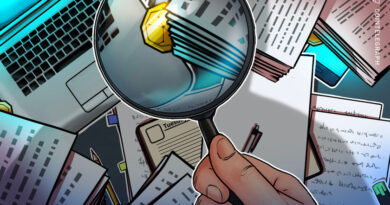Crypto PR: The good, the bad and the shoddy
Like most crypto journalists, Will Foxley has a horror story about a bad encounter he had with a dodgy PR person. The former tech reporter at CoinDesk recalls being embarrassed in his first few days on the job after he relied on bad information fed to him in an announcement.
I got burned by a bad PR agent within, like, two or three weeks on the job, where they gave me false press release information, he says. I didnt quite verify it enough and then got called out by one of the higher industry people. Thats like the quickest way to ruin your relationship with a journalist.
Hes quick to add a disclaimer that there are some great PR people out there, but he estimates the good guys only account for about 20% of the industry. The lower 80% either dont care about, or dont understand the technology, or the fact journalists put their reputations on the line whenever they run a story.
They only have an interest in pumping whatever the coin theyre tasked with pumping and getting whatever company they need into whatever headline, which is really unfortunate. And it leads to a lot of burnout among journalists, and a lot of frustration.
Fortunately, the best crypto PR practitioners understand how to play the game and act accordingly. The most important currency we have is trust, says David Wachsman, founder and CEO of the eponymous PR firm. We have to earn that because the one thing I know for certain is reporters are a cynical bunch, and they know when something feels off.
Its a dangerous game to get wrong because PR agents and sometimes entire agencies can get blacklisted by publications or develop a bad reputation industry-wide, explains Foxley.
If you dont like a PR person, you tell at least everyone that youre working with at your organization, says Foxley, who is now the editorial director at Compass Mining. I saw that quite often. Youre like, Theyre from that firm? Dont talk to them.
Emerging industry
The world of crypto PR is an emerging industry of specialist PR firms that are responsible for a large proportion of the crypto news out there. Co-founding president of the Association of Cryptocurrency Journalists and Researchers Joon Ian Wong says that good PR agents play a much-needed role.
I think PR people in any sector, including crypto, are an important part of the information landscape, he says. Their job is to ensure that information flows easily and freely to the media. He adds: But clearly they work for clients, so, you know, you can have issues with conflicts of interest.
Samantha Yap says PR agencies do a lot of work behind the scenes as the interface between crypto projects and journalists. Half our time is literally educating our client on how the media works, she explains.
We spend a lot of time telling them: Oh, you cant put this promotional angle out because journalists are not going to write about it, weve got to take a more newsworthy angle, or try to fit the story in the context of the wider industry.
She continues: What the journalists see in their inbox is like two weeks of brainstorming work at times it works, at times it doesnt.
Laundry list
Although Foxley is a big fan of Yap and calls her a legend, he has a laundry list of complaints about the vast majority of pitches he receives. But the biggest issue is that in a full-to-the-brim inbox, there are usually only a couple of useful leads among a sea of boring or irrelevant non-news.
So 80% is just dog trash, Foxley says. Ive just seen some horrendous pitches over my years at CoinDesk, and frankly, I dont quite understand why those pitches are made the way they are.
Theyre not helping themselves out.
Some pitches massively oversell the potential benefits of whatever unproven technology theyre pumping, while others appear to have been bulk emailed to every journalist in the world. Many are unfamiliar with the fundamental requirements of journalism (which is that stories need to be newsworthy by being either important, unique or very interesting), but one common issue is a lack of technical understanding.
More often than not, especially as a tech reporter, I saw PR pieces that didnt understand the tech that they were describing, he explains. You get a PR guy or gal who doesnt exactly understand it, and theyre trying to explain what a ZK-Rollup is. No, firstly, you dont know how to describe it, and this is the wrong context.
PR news
This isnt to say crypto journalists always cover themselves in glory either when they receive a newsworthy pitch. Yap sums up up the mission of PR agents simply and eloquently:
The sign and the skill of a good PR person is to pitch journalists the best possible angle in the way we want them to write it.
In an ideal world, of course, journalists would use a story pitch as the starting point, research the background, and speak with outside experts before producing a well-thought-out and balanced article that contributes to better understanding in the cryptosphere.
What actually happens far too often is that press releases are given the barest rewrite before being uploaded.
There are many reasons for this: low rates of pay on some crypto sites and a constant need to feed the beast i.e., the website updated and new content. It leads to what is known as churnalism.
[jnews_carousel_3 enable_autoplay=”true” autoplay_delay=”4500″ post_offset=”1″ include_category=”157″]
Foxley concedes that writing four or more news stories a day can be mind-melting, and its very easy just to lean on the press release and the story thats given to you. Its just fodder for the story. But its not good for the industry; its not good for readers.
Thats why Im a fan of less stories per day from a news publication per day because I dont see another way of getting rid of that.
Leslie Ankney has been on both sides of the fence, as a contributor to The Merkle and Forbes, a PR specialist at Ditto PR and communications lead at Anchorage Digital Bank. Im sure there are times when youre under deadline its probably tempting, she says, adding:
Hopefully, as a reporter, you have insights and questions to follow up with, something that the press release didnt cover. But I understand that maybe if you have to turn out five pieces a day you may not have time.
Wong says this is not a problem unique to crypto media. I think you see the same thing with a lot of finance reporting, he says. You see the same thing with listed stocks, penny stocks, and so on. Theres lots of blogs and publications out there that do the same thing.
The ACJR aims to improve standards in crypto journalism, and Wong points out that the more well-resourced a crypto publication is, the more likely the staff has been conditioned to be wary of running any messages a PR person wants to convey:
Based on what I know of the reporters who work at some of these places […] they tend to be more skeptical and more critical about announcements and other notices put out by crypto PR folks, and because they work in crypto media, they are better equipped to actually cut through a lot of the marketing speak or the PR speak and get to the heart of the matter.
Foxley agrees that some journalists always view PR people with suspicion. I had some colleagues at CoinDesk that refused to interact with any PR people because they saw it necessarily tainting their work.
How did we get here?
Wachsman is one of the biggest players in crypto PR, with 80 staff across offices in New York, Dublin and Singapore and clients including Cosmos, Hedera Hashgraph and NEM. The Financial Times recently named it one of the 500 fastest-growing companies in the Americas.
It traces its history back to when David Wachsman bumped into the CEO of Coinsetter in a bar in 2014. This led to Wachsman learning about Bitcoin and taking the exchange (later sold to Kraken) on as a client. He struck out on his own as a crypto specialist in 2015 and quickly signed up clients including Trezor, Slush Pool, Airbitz and the Coinsource Bitcoin ATM network.
Wachsman wasnt the first crypto PR specialist. He credits Michael Terpins Transform PR with that honor, but he says those two firms were pretty much the extent of the crypto PR industry at that time.
It wasnt the wild west; it was non-existent, he recalls. Most of the time it was founders directly emailing reporters. They didnt know the right protocol. Sometimes, they werent very informative; they didnt answer questions appropriately or in a timely fashion.
I remember reporters being thrilled when you could do something like send them a high-resolution headshot, he says.
When crypto firms needed publicity, they sometimes used mainstream PR agencies. Wong recalls how non-specialist often had zero understanding of what it was they were promoting. I often knew a lot more than the PR person about what their client was doing, he says.
Whether it was a PR who was telling me about Bitcoin mining or some esoteric financial thing, a lot of folks at big agencies have no clue whats going on in cryptocurrency.
Wachsman says a critical mass of specialist crypto PR firms didnt appear until after the initial coin offering boom in 20172018. Very few reporters, and consequently PR professionals, were paying attention, he says.
Scams, spam and pay for play
Into the void stepped cryptos infamous guerilla marketing and PR campaigns. Michael Whitlatch is now the creative director at North Equities, which conducts respectable digital marketing and PR campaigns for regulated listed companies.
But during the ICO boom, he fell into a very different job after convincing 300 people in six weeks to use his referral code to buy a coin. I realized I kind of had a knack for this kind of thing, he says.
Whitlatch and his team were responsible for spreading the word on social media about projects. If youve ever interacted with someone on Reddit, Facebook or 4Chan who has a high degree of knowledge about a coin and a very positive attitude toward it, you may have met them. If social sentiment in a projects Telegram group was turning sour, it was the job of Whitlatch and his team to jump in the chat to spread positive vibes and information to help turn it around.
It was a much more sophisticated effort than the infamous bounty campaigns of the era that saw armies of people liking pages and writing spammy tweets about a project, often in broken English, for a handful of coins per task.
Often, I would say bounty campaigns eventually wound up hurting companies, Whitlatch says. Because they did come across with the full shilly force of mistyped posts, he says.
Whitlatchs team stopped working in the area due to increasing regulations. It was looking like it was going to go the way of securities, and we didnt want to get involved with anything illegal, he says.
Astroturfing
Whitlatchs team was at the more respectable end of such endeavors and genuinely believed in the projects it promoted seeing it as a way to invest in them as they were invariably paid in tokens.
But others were much more mercenary. One ICO promotion outfit email doing the rounds in 2018 asked for a $22,000 monthly retainer for astroturfing an entire social media campaign, in which fake posts would be retweeted by fake accounts with fake followers, and entire Reddit threads fabricated by one guy with 10 sock puppet accounts:
I can put you on the front page of any subreddit I want. I can get you a positive reaction from the basement dwellers at /biz (who spend a lot on crypto by the way). I can put you on the front page of Hacker News … I can kindle positive organic discussions about your company in places where other ICOs get torn to shreds.

Other shady crypto and marketing PR firms openly offered guaranteed placement in publications like Forbes and Huffington Post for a flat fee. TechCrunch reporter John Biggs wrote in 2018 that he was offered payment for posts almost every day and almost all the journalists I talked to reported the same. Most declined, but some did not. I heard about these things, says Ankney, who adds:
I found that really appalling. I was really angry and frustrated because even though I dont have a journalism degree, I still held myself to a high journalistic standard. And I was shocked that others did not.
There are still some echoes of these services today, such as Bitcoin PR Buzz, which bills itself as the Worlds First Crypto PR Agency and claims to have helped 850 clients raise half a billion dollars. It offers the Breakthrough Article Pack for $13,997, which includes the services of a writer to put together a bespoke article thats distributed on a variety of crypto sites including BeInCrypto, Bitcoinist and NewsBTC, among others.
Of course, theres nothing unethical about running a sponsored article as long as its clearly identified as such, and it can only be presumed this is Bitcoin PR Buzzs practice. However, these examples linked on this site are not tagged as sponsored posts.
The professionals
Fortunately, as the industry became more and more professional, the PR and marketing cowboys began to disappear.
I think its professionalized, says Foxley. I was not there in 2017 and 2016, so I wont say anything about that. But I think PR people are more available; they understand the space more; they have an interest in maintaining relationships for the long term.
There were a few false starts along the way. Wachsman explains that the first wave of professional PR specialists emerged in 2018 only to be hit hard by crypto winter toward the end of the year.
[jnews_carousel_3 enable_autoplay=”true” autoplay_delay=”4500″ post_offset=”1″ include_category=”157″]
We saw the exit of a number of firms, including global agencies at the time. And not many of them were there for the real ascent of the industry in 2020. Wachsman himself was forced to lay off 16 out of the 110 staff.
It was rough because our team is so tight-knit that it felt like it was ripping out your left arm, he says. But Wachsman survived and has since been joined by a raft of new firms.
One of those firms is Yap Global. Samantha Yap began her career as a broadcast journalist in Asia before jumping the fence to PR and later becoming enamored with crypto. She founded Yap Global in 2018, which has now grown to a team of 10 with clients including FTX, Enjin and Nexo.
One of the most misunderstood things about PR, explains Yap, is that its not just about creating and sending out messages. Its also about carefully cultivating relationships with journalists and editors. People forget that PR is not like advertising and marketing. Its about relationships, she says. Its a two-way street.
At its best, PR and journalism are a mutually beneficial relationship, in which journalists are connected to relevant information and interviewees, while PR agencies are able to get coverage for their clients.
The relationship is important to tend to, as when it goes wrong, it can be very bad indeed. Foxley recalls a long-running feud between a well-known crypto PR agency and CoinDesk after the editors had become unhappy with how some stories had played out and blacklisted them.
Some higher-profile people kept pitching us during it, and I think we stopped taking their stuff, he says. Foxley recalls getting an ear-bashing from the PR firms founder one day.
He just went off on me about how we werent correctly running (the agencys) stories. And I was like, Bro, Ive never talked to you before, and then it ended up just him and (executive editor) Marc Hochstein talking for two hours on the phone and him complaining about CoinDesk and then I think things normalized.
PR on news stories
While PR agents are often tasked with chasing journalists, what is equally important is how they deal with journalists when they start being chased themselves.
Journalists who always need a response by five minutes ago may not appreciate how much work goes on behind the scenes, says Ankney. She works in-house for Anchorage, which in January was given the approval to launch the first federally chartered crypto bank in the United States.
Pretty much everything that we say has to be legally approved, which I think is probably a part of why its hard for reporters if you need a source in two hours, she says. Its definitely difficult sometimes to get things approved in time.
One of the trickiest situations for any PR professional is how to respond publicly during a crisis. One of the biggest bad news stories any crypto PR firm is likely to deal with is an exchange hack, where millions of dollars and millions of unhappy users are involved.
Wachsman has worked with Kraken, Bitfinex and Bitso over the years and says the first order of business is to prepare a detailed plan on how to respond to a potential hack accounting for all the different stakeholders while keeping one eye on the legal ramifications across multiple jurisdictions.
When you work with an exchange, one of the first things you do is you prepare that playbook, and its quite extensive, he says. Timely and accurate updates are the only way to play it, according to him. You need to go and give them as much information as you can, that you know for certain is accurate, he explains.
Or else, what youre going to do is create Im going to call it the shitstorm.
In the past, plenty of exchanges have attempted to spin a cover story about system maintenance to cover up a hack, but thats playing with fire in a world of crowdsourced fact-checking by highly motivated users on social media.
Everything is found out at some point, says Foxley. Thats just how it goes. Like you cant keep a secret in crypto. Thats, like, the tagline, right: Dont trust, verify. So, I would not do that. I would be honest.
*Thank you to Elias Ahonen for interviewing Samantha Yap for this story.
[jnews_carousel_3 enable_autoplay=”true” autoplay_delay=”4500″ post_offset=”1″ include_category=”157″]




